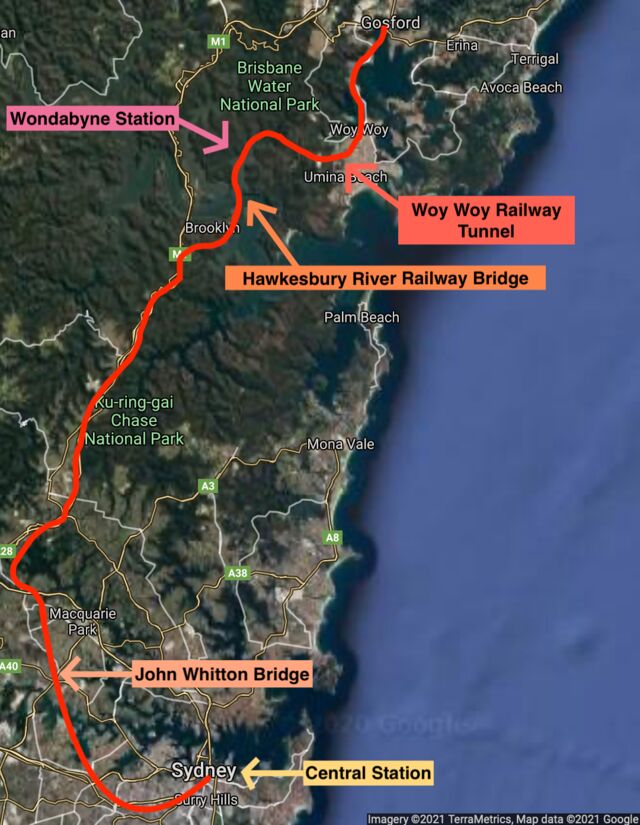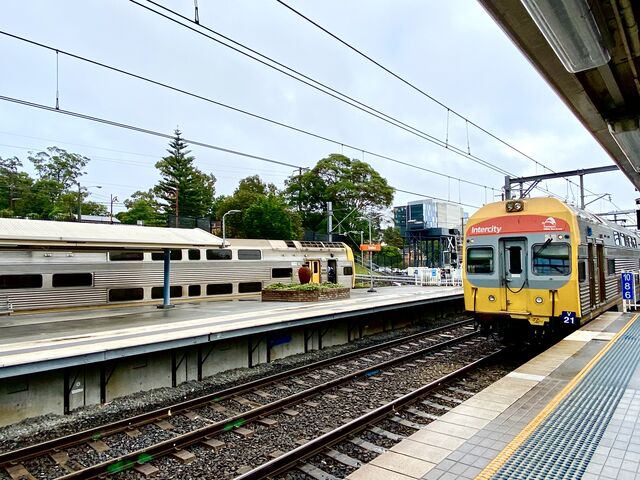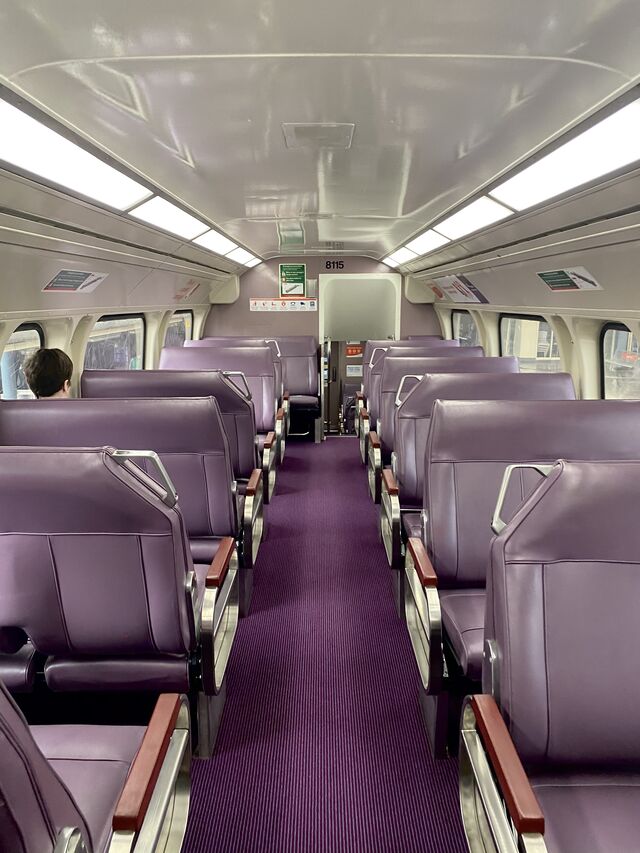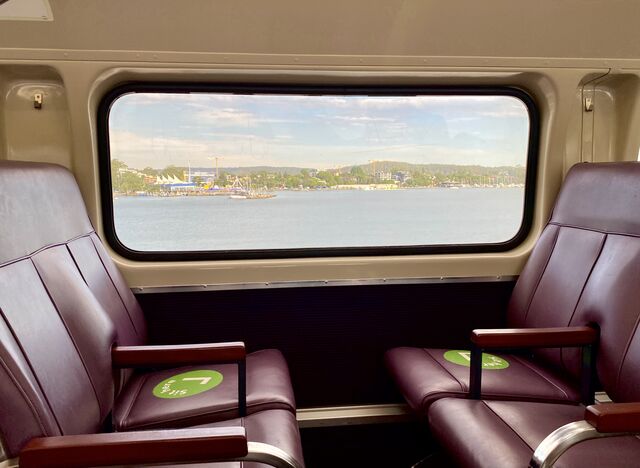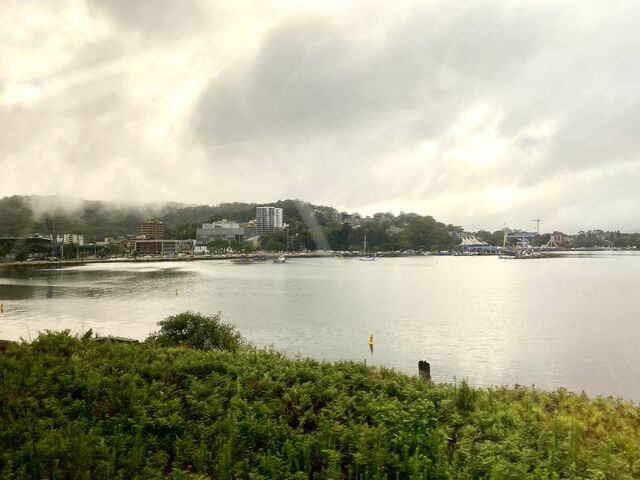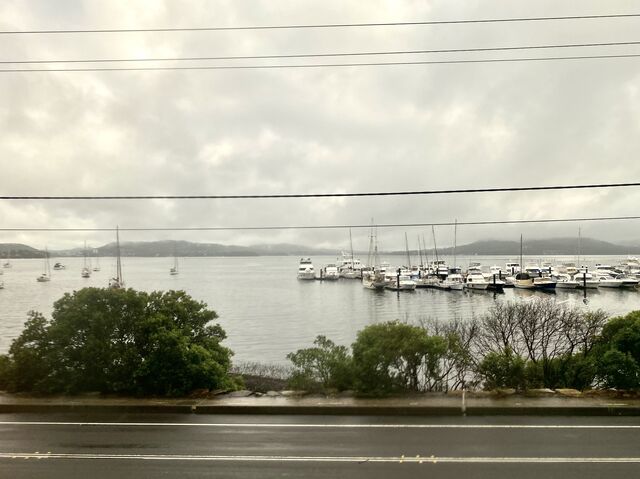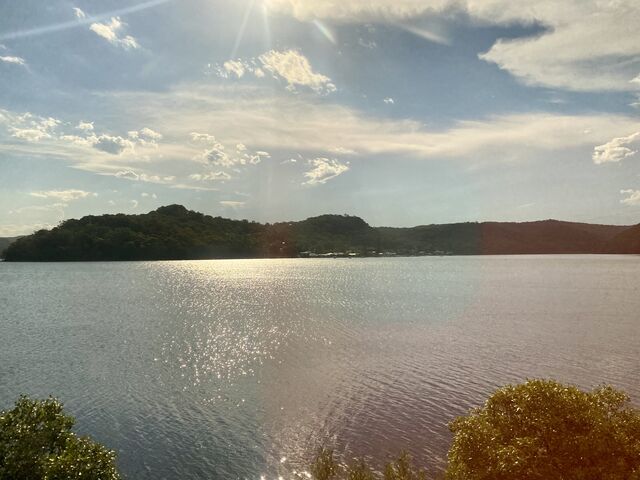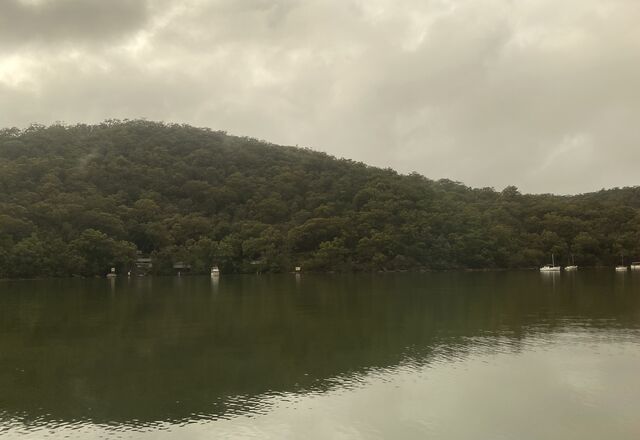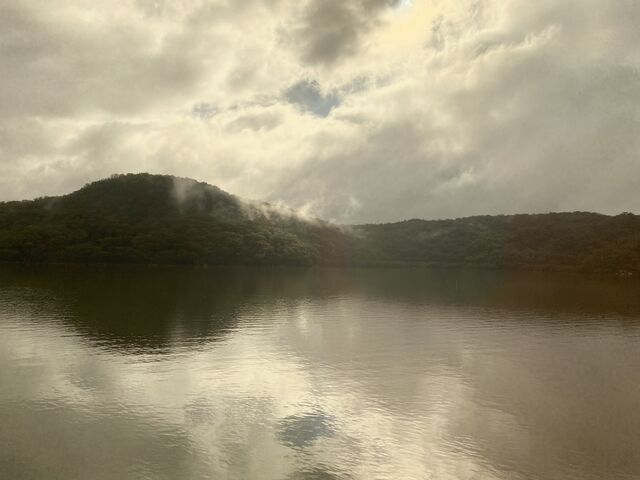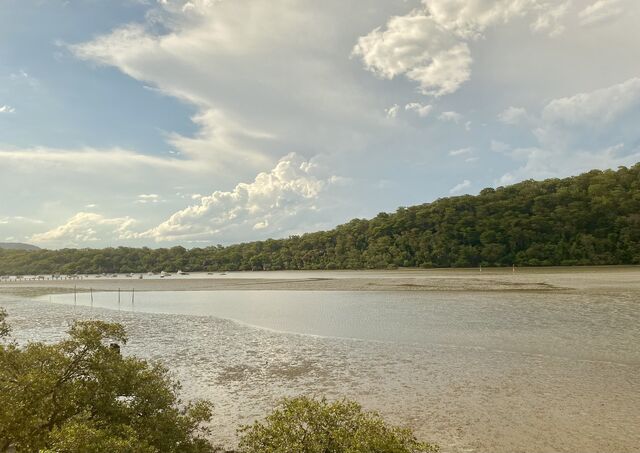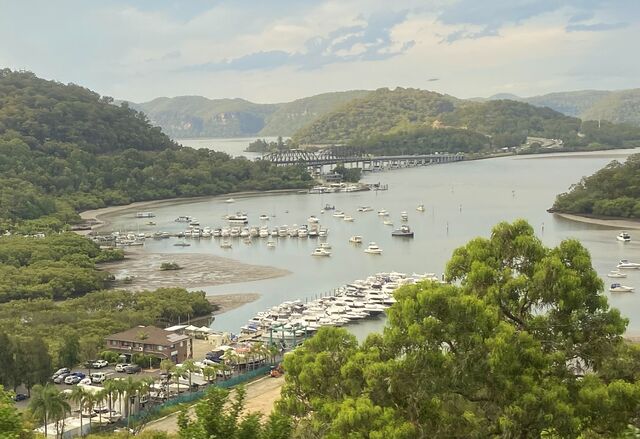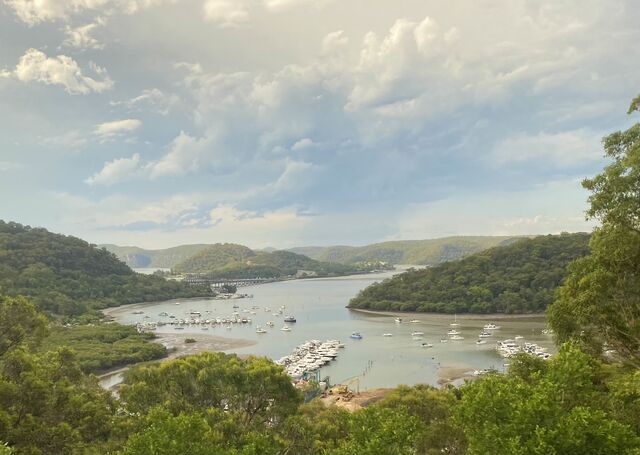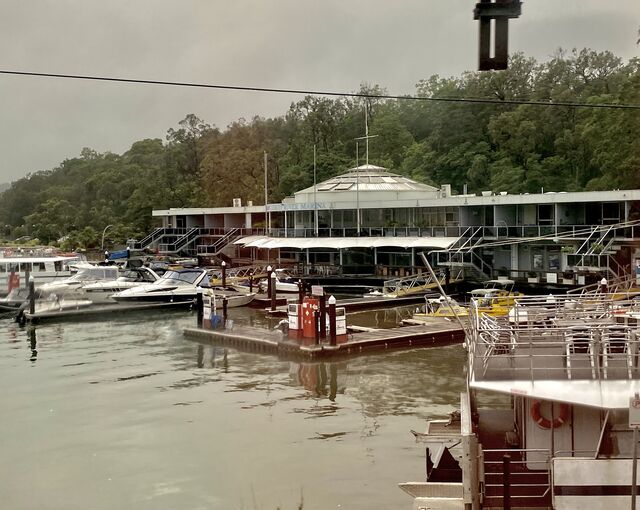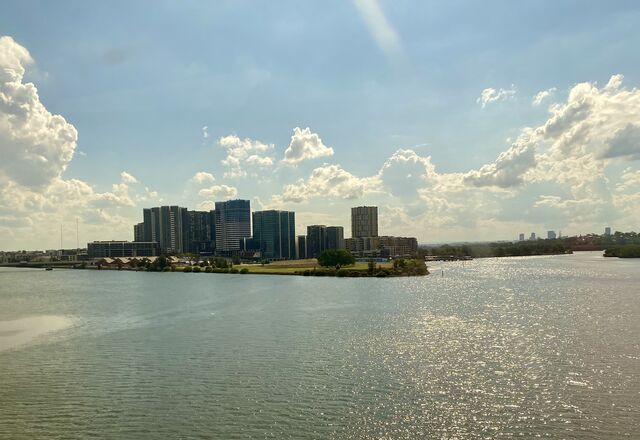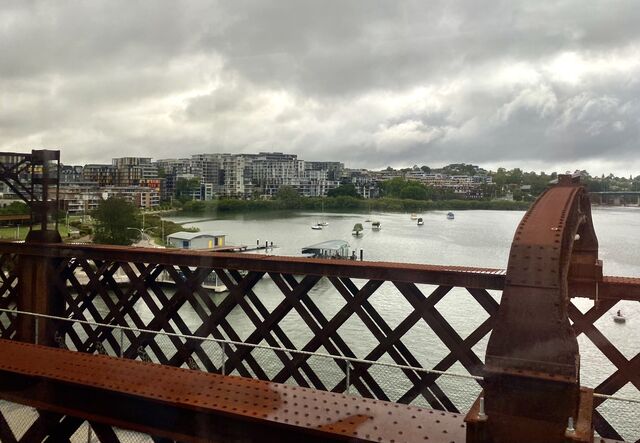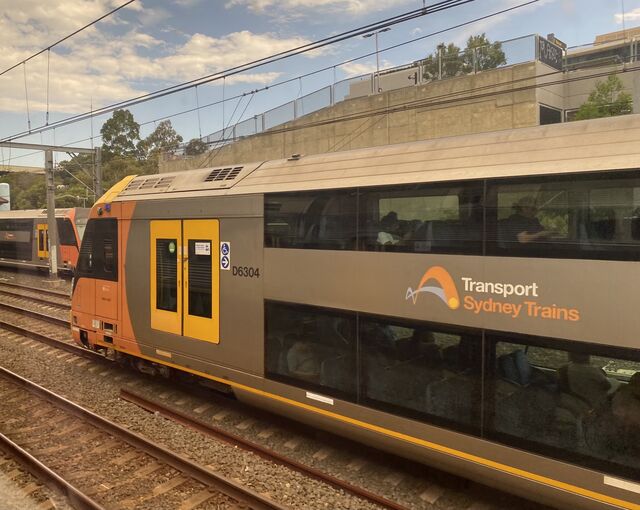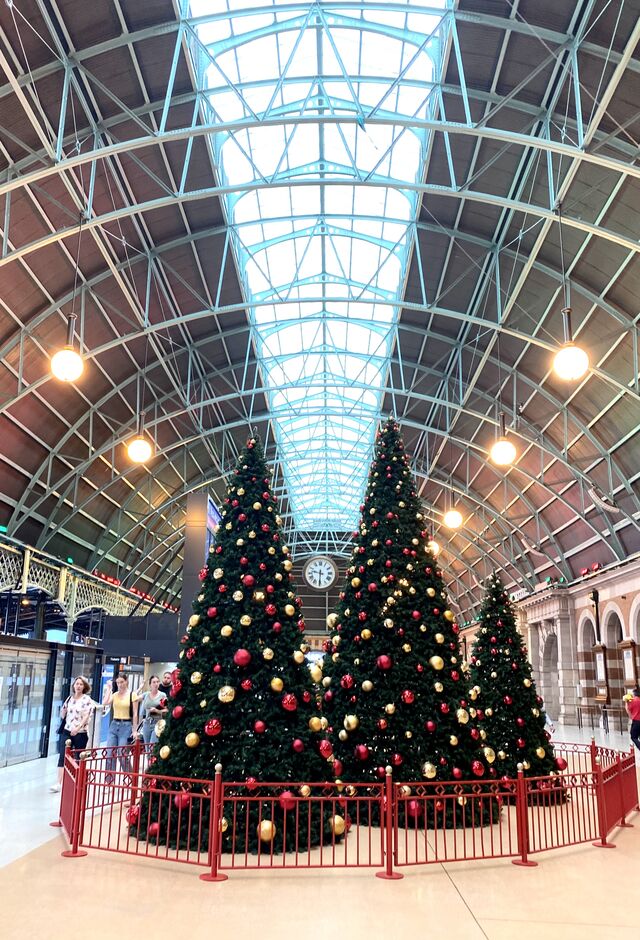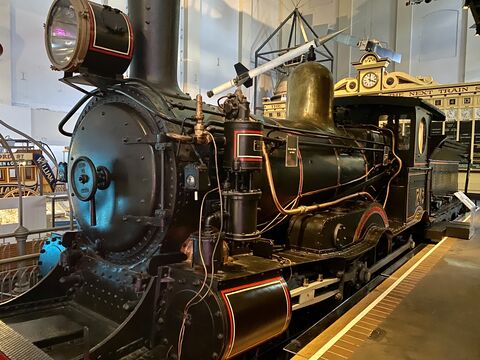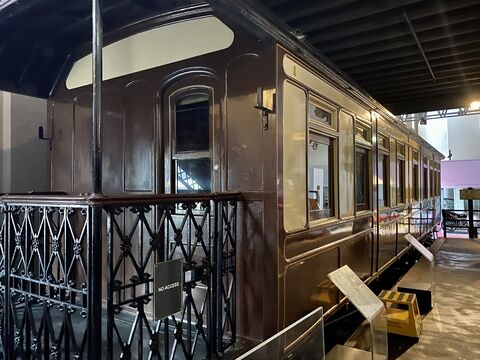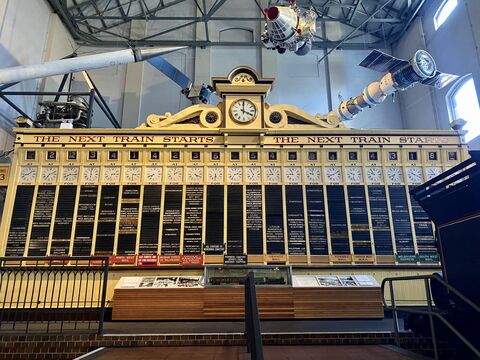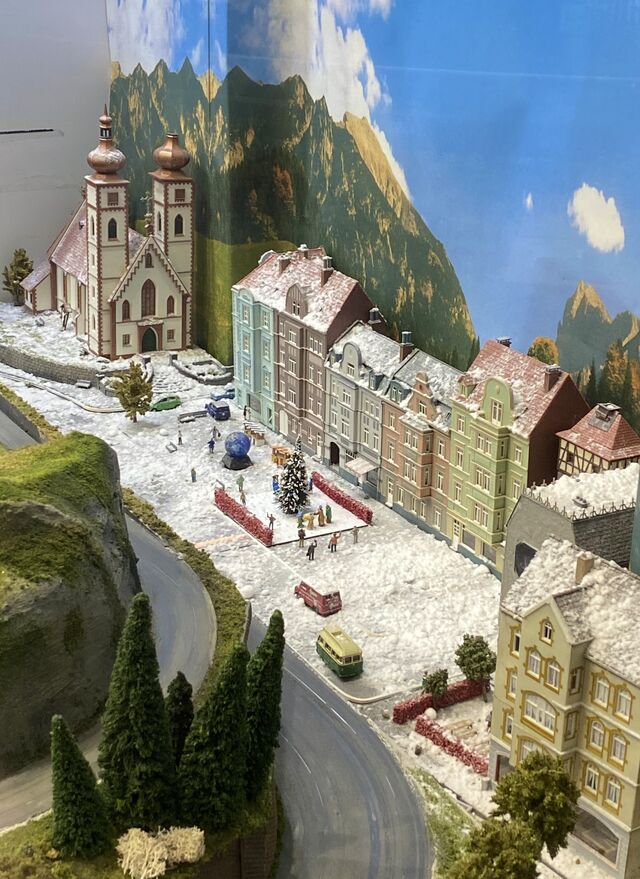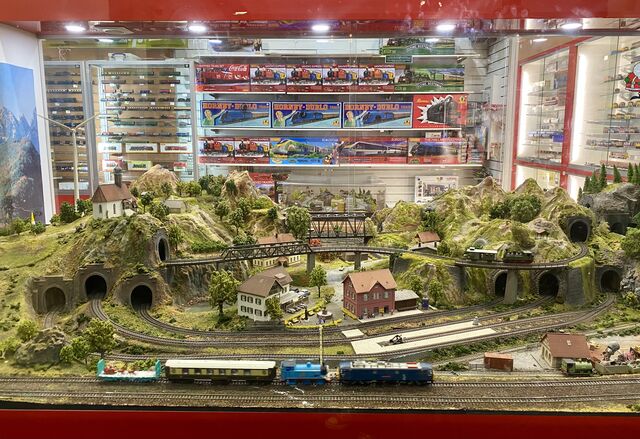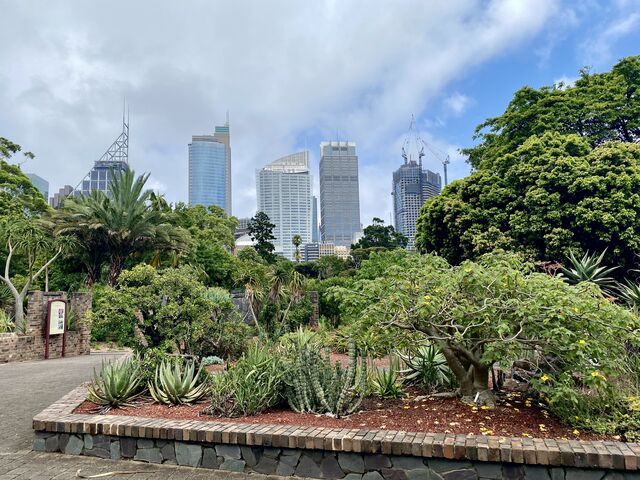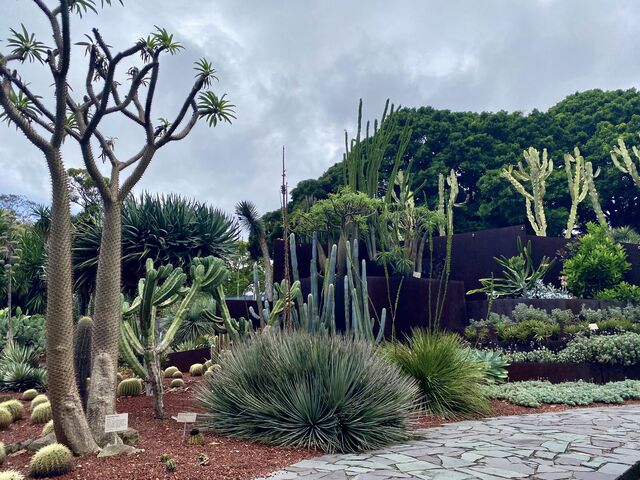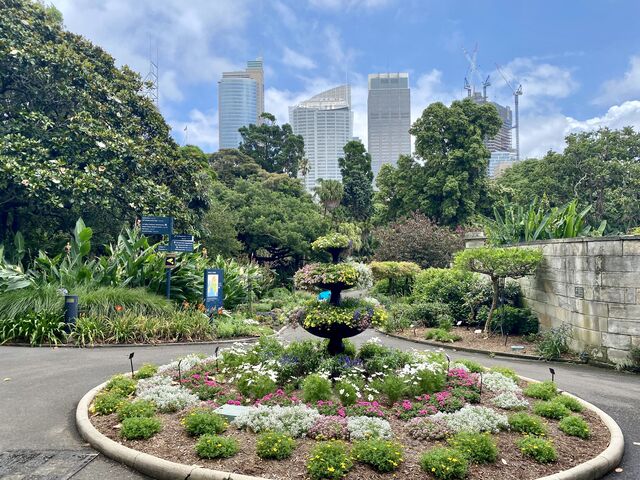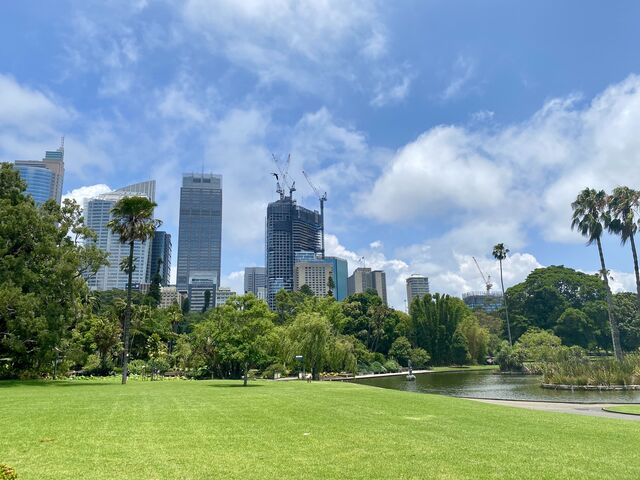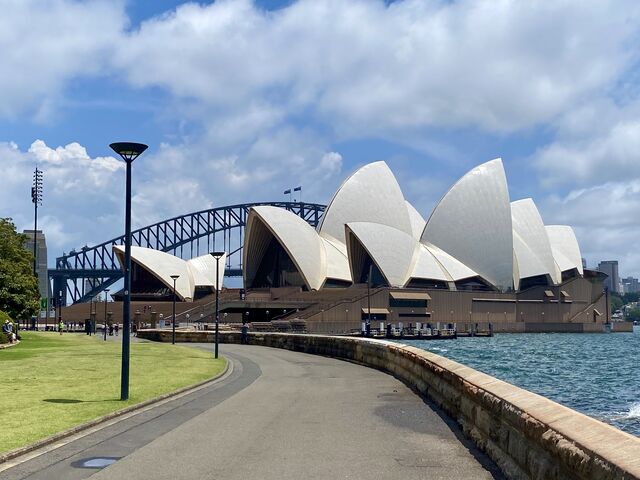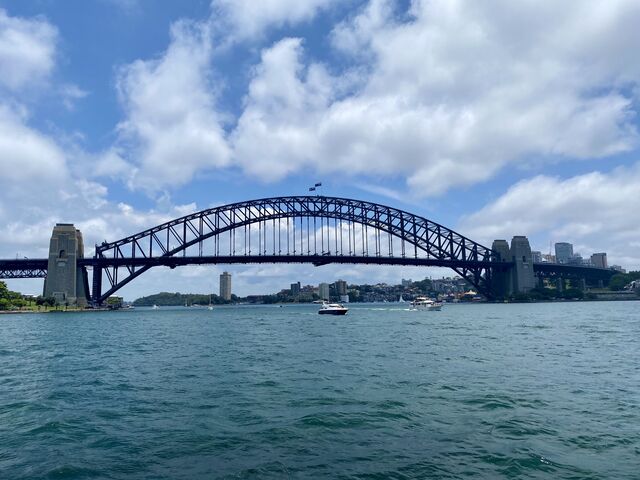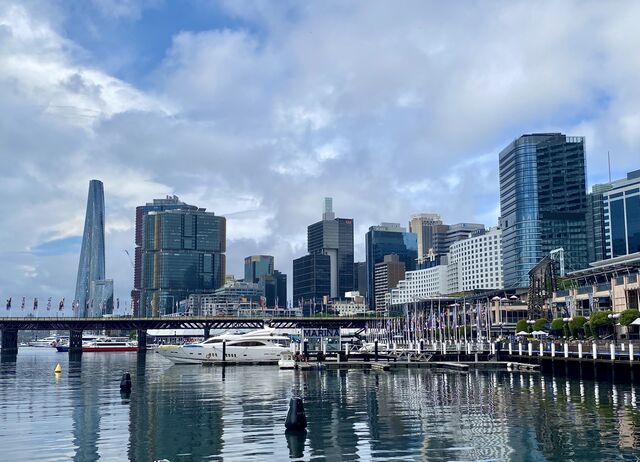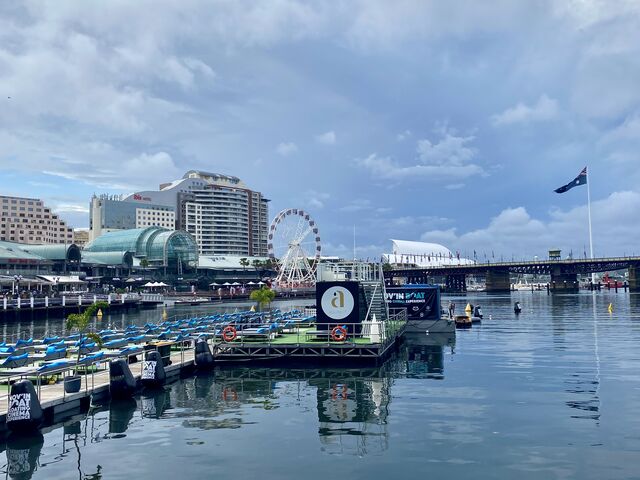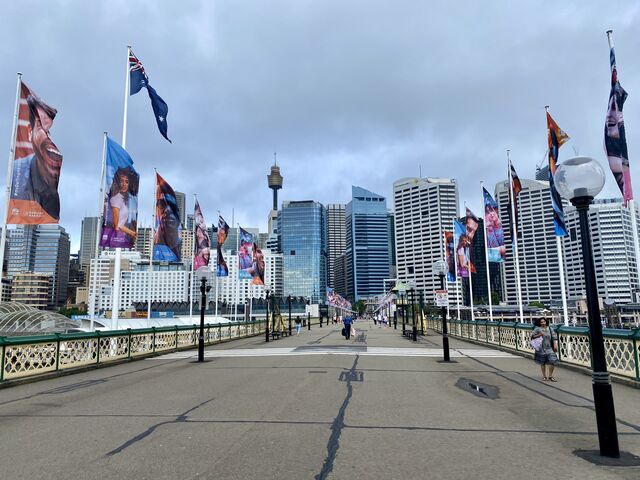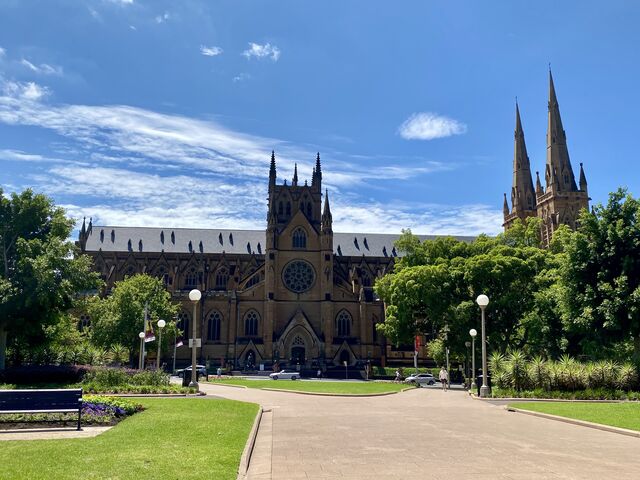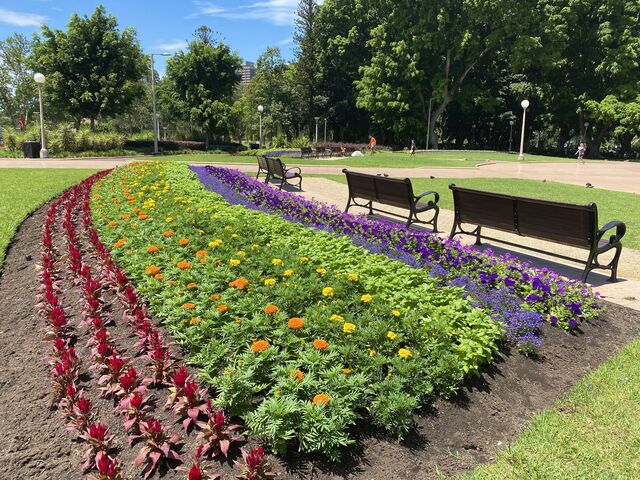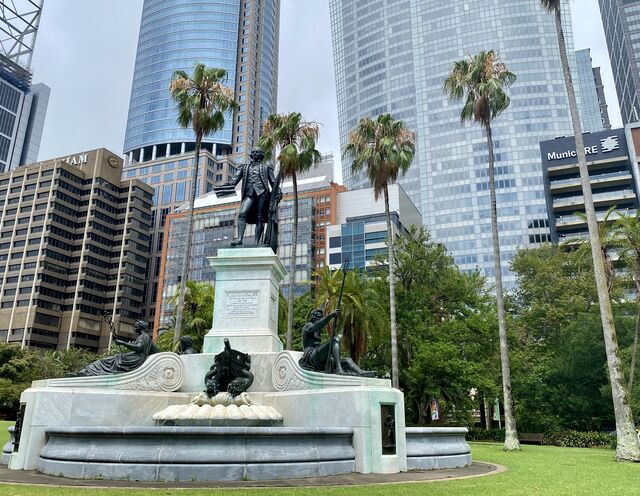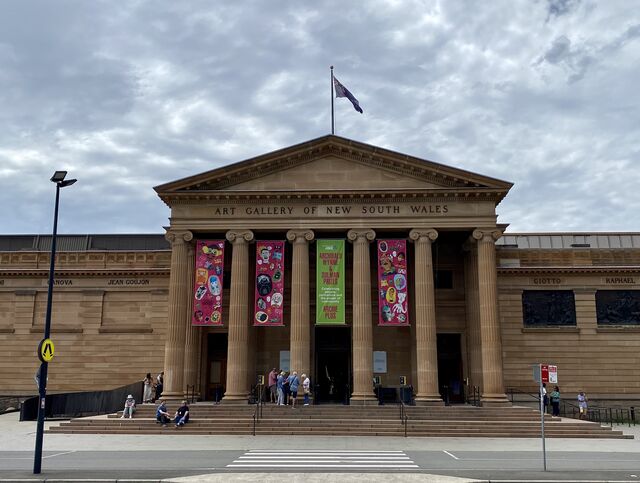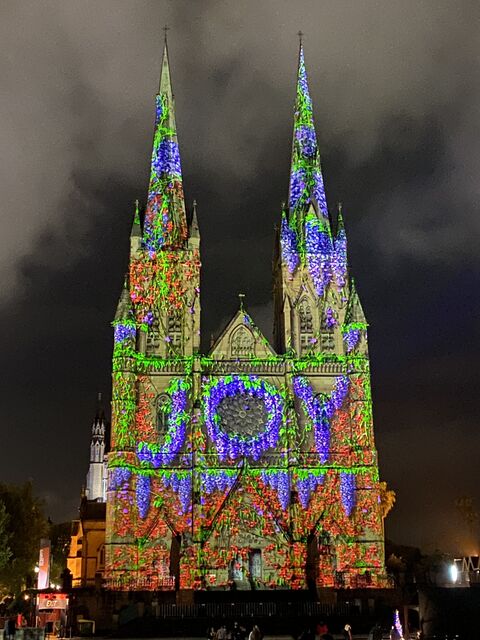Gosford–Sydney by Train
The Central Coast and Newcastle Line runs along the Main North Railway Line (formerly known as the Great Northern Railway) in New South Wales, connecting the state’s two largest cities – Sydney and Newcastle. I have taken this train trip many times before, but the particular journey which this blog entry relates to was taken in December 2020. My trip was between Gosford on the Central Coast of New South Wales and Sydney’s Central Station. The trip took approximately 1 hour and 40 minutes.
The pictures below show the interior of the train. The carpet and seats are a shade of purple known as ‘bush plum.’1 The current V-Set carriages are set to be replaced in early 2021, with upgrades including wider seats and charging ports for mobile devices.2
The last carriage provides excellent views of the train as it sweeps around the bends on this journey. My travel companion and I were originally seated in the last carriage but relocated after realising it was a ‘quiet carriage’ where conversation is a train etiquette faux pas.
The journey from Gosford Station starts on a high note as the train rolls alongside Brisbane Water.
The first point of interest, and the first major engineering feat to be encountered on this journey, is the 1.79km Woy Woy Railway Tunnel. The tunnel has historic significance, being the longest tunnel in Australia at the time of its construction.3 The tunnel has also been identified as providing ‘a powerful aesthetic break in the rail journey between Sydney and the Central Coast separating the rugged beauty along Mullet Creek from the flat urban sprawl of Woy Woy and Gosford’.4
Shortly after, the train stops at Wondabyne Station – the only railway station in Australia that does not have road access!5 You can read about this unique station in my blog post here.
The next point of interest en route is the Hawkesbury River Railway Bridge which connects Cogra Bay on the Central Coast with Brooklyn on the northern outskirts of Sydney. The bridge is the second major engineering feat encountered on this railway line. My travel companion and I were seated near a NSW TrainLink employee who, having observed us taking pictures out the train’s window, pointed out the bridge as we approached.
When the original bridge was constructed in 1889 it was the longest bridge in Australia and the fourth longest in the world. It also had the deepest bridge footing in the world.6 The bridge not only linked Sydney and Newcastle, but was the final section of track needed for a continuous rail link between South Australia, Queensland, Victoria, and New South Wales. The bridge’s construction attracted international media attention and on the occasion of the bridge’s opening, Sir Henry Parkes – Australia’s “Father of Federation” – observed: “I feel that the toast entrusted to me represents an event superior to anything that has ever occurred in the history of these great colonies. We are, without any exaggeration of language, assembled here to celebrate an occurrence which has more interest, especially in anticipation of the future, than anything else that has taken place in our history. We have formed a communication by railway which may be said to bind the whole population of Australia in one chain… “7
Prior to the bridge’s construction, passengers were required to transfer to a paddle-steamer in order to cross the Hawkesbury River. The journey took nearly two hours and, in addition to being a significant impediment to efficient railway travel, the paddle-steamer often had to traverse dangerous waters.8 The bridge’s strategic significance was envisaged by fiction authors and politicians who wrote about the invasion of Australia and destruction of the railway bridge in order to cut the movement of men and supplies between Sydney and Newcastle.9
Concerns that the original bridge would not suffice when it came to supporting the extra loading and traffic demands of World War II led to the construction of a replacement bridge in 1939. The current bridge opened in 1946 and is located a short distance upstream from the 1889 bridge.10
After a stellar first 30 minutes of the journey, the next hour on the Main North Line is fairly monotonous as the train continues south to Sydney. The scenery picks up again as the train crosses the John Whitton Bridge over the Parramatta River. The next point of interest en route is Sydney Olympic Park – the home of the 2000 Olympic Games.
At Strathfield, the line joins Sydney’s Main Suburban Line. The final part of the journey is once again a fairly mundane experience as the train rolls through suburban Sydney.
My travel companion and I alighted at Central Station, taking a moment to appreciate the Christmas decorations in the station’s main concourse. Sydney’s first Central Railway Station was opened in 1855 and consisted of a single 30.5 metre wooden platform and a corrugated iron shed.11 Melbourne’s predecessor to Flinders Street Station – ‘Melbourne Terminus’ – was Australia’s first city railway station in 1854, beating the opening of Sydney’s Central Station by a year.12 In 1916, the Battle of Central Station saw soldiers who were rebelling against camp conditions during World War I destroy station facilities. Evidence of the resulting gun battle can apparently be found near platform 1, with a small bullet-hole in the marble by the entrance to the platform.13 Observant commuters will also notice the extra-long escalator ride that is needed to reach platforms 24 and 25. These platforms are situated below two unused ‘ghost platforms’ which are complete, apart from their tracks. In the early 1990s, it was proposed that these platforms be used for a bullet train to Melbourne.14 Please refer to the Melbourne–Sydney blog post for more information on proposals for a high-speed rail link between these two cities.
Sydney
The below images show the main attractions I visited during my 24 hours in Sydney. The highlight of the trip was a visit to the Powerhouse Museum where a number of old train carriages and locomotives are on display.
The first photograph is of Locomotive No 1 which has been located in the Powerhouse Museum for over 120 years. Locomotive No 1 is significant for hauling the very first passenger train to run in NSW in 1855. The locomotive arrived in Australia via ship from England, having been ordered by the Sydney Railway Company to run on the line between Sydney and Parramatta.
The second photograph is of Locomotive 1243 which began service in 1882 and pulled express passenger services on the NSW main lines. It was widely sough-after to star in films, displays, and vintage train tours.
The third photograph is of the Governor’s Carriage which was built in 1891. It was used by Australia’s colonial governors, who, as representatives of royalty, were expected to travel in style. In 1901, the visiting Duchess of Cornwall and York (later to become Queen Mary) used the carriage on trips between Sydney and Katoomba.
Train enthusiasts visiting Sydney may also enjoy a visit to the Hobbyco store in the Queen Victoria Building. There is a wide range of model trains, tracks, and accessaries for sale, in addition to an impressive model train village on display in the store’s window. I particularly enjoyed the village’s snow covered streets and buildings and will be sure to incorporate this effect into my own future model train village.
I also visited Sydney’s Royal Botanic Garden, which was established in 1816 and occupies more than 27 hectares along the shores of Sydney Harbour. There are approximately 5000 different kinds of plants under cultivation.15
Other attractions I visited in Sydney included Circular Quay (from where there are great views of the Harbour Bridge and Opera House), Darling Harbour, Hyde Park, and the Art Gallery of New South Wales.
When darkness fell, I enjoyed taking Sydney’s self-guided Christmas lights and decorations walk.
A highlight of the experience was the Christmas light projections on St Mary’s Cathedral – Australia’s largest Cathedral building. The original St Mary’s Cathedral was destroyed by fire in 1865.16
Overall, the Gosford–Sydney segment of the Main North Railway Line is pleasant enough, with the attractive scenery and points of historic significance during the first 30 minutes of the train’s journey making up for the rather lacklustre scenery the remainder of the way to Sydney.
Blue Mountains Gazette, ‘New Rail Boss Tries out Refurbished Trains’ (3 July 2013, online). ↩︎
NSW Government, Transport for NSW, ‘New Intercity Fleet’ (8 December 2020, online). ↩︎
NSW Government, Office of Environment & Heritage, ‘Woy Woy Railway Tunnel’ (online). ↩︎
Ibid. ↩︎
Paul Boon, The Hawkesbury River: A Social and Natural History (CSIRO Publishing, 2017) 375. ↩︎
NSW Government, Office of Environment & Heritage, ‘Hawkesbury River Rail Bridge and Long Island Group’ (online). ↩︎
Ibid. ↩︎
Boon (n 5) 370. ↩︎
Ibid 428–9. ↩︎
NSW Government (n 6). ↩︎
Visit Sydney Australia, ‘Central Station’ (online, 2019). ↩︎
Ibid. ↩︎
Ibid. ↩︎
Ibid. ↩︎
Britannica, ‘Royal Botanic Gardens’ (online). ↩︎
St Mary’s Cathedral, ‘History of the Cathedral – Living our Heritage’ (online). ↩︎
